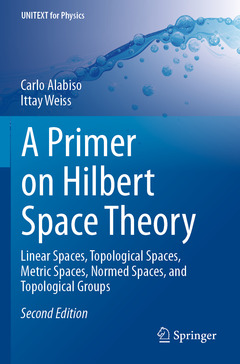A Primer on Hilbert Space Theory (2nd Ed., 2nd ed. 2021) Linear Spaces, Topological Spaces, Metric Spaces, Normed Spaces, and Topological Groups UNITEXT for Physics Series

This book offers an essential introduction to the theory of Hilbert space, a fundamental tool for non-relativistic quantum mechanics. Linear, topological, metric, and normed spaces are all addressed in detail, in a rigorous but reader-friendly fashion. The rationale for providing an introduction to the theory of Hilbert space, rather than a detailed study of Hilbert space theory itself, lies in the strenuous mathematics demands that even the simplest physical cases entail. Graduate courses in physics rarely offer enough time to cover the theory of Hilbert space and operators, as well as distribution theory, with sufficient mathematical rigor. Accordingly, compromises must be found between full rigor and the practical use of the instruments. Based on one of the authors?s lectures on functional analysis for graduate students in physics, the book will equip readers to approach Hilbert space and, subsequently, rigged Hilbert space, with a more practical attitude. It also includes a brief introduction to topological groups, and to other mathematical structures akin to Hilbert space. Exercises and solved problems accompany the main text, offering readers opportunities to deepen their understanding. The topics and their presentation have been chosen with the goal of quickly, yet rigorously and effectively, preparing readers for the intricacies of Hilbert space. Consequently, some topics, e.g., the Lebesgue integral, are treated in a somewhat unorthodox manner. The book is ideally suited for use in upper undergraduate and lower graduate courses, both in Physics and in Mathematics.
Prof. Carlo Alabiso obtained his degree in Physics at Milan University, Italy, and then taught for more than 40 years at Parma University, Parma, Italy (with a period spent as a research fellow at the Stanford Linear Accelerator Center and at CERN, Geneva), until his retirement in 2011. His teaching encompassed topics in Quantum Mechanics, special relativity, field theory, elementary particle physics, mathematical physics, and functional analysis. His research fields include mathematical physics (Padé approximants), elementary particle physics (symmetries and quark models), and statistical physic (ergodic problems), and he has published articles in a wide range of national and international journals, as well as the previous Springer book (with Alessandro Ciesa), Problemi di Meccanica Quantistica non Relativistica.
Dr Ittay Weiss received his PhD in Mathematics from Utrecht University, the Netherlands, in 2007. He has published extensively on algebraic topology, general topology, metric space theory, and category theory, and has taught undergraduate and postgraduate mathematics in the Netherlands, Fiji, and England. He is currently a Senior Lecturer in Mathematics at the School of Mathematics and Physics, University of Portsmouth, UK. Born in Israel, his first encounter with advanced mathematics was at the age of 16 while he was following computer science courses at the Israeli Open University. So profound was his fascination with the beauty and utility of mathematics that, despite the digital economic boom at the time, he enrolled, as soon as he could, for the BSc program in Mathematics at the Hebrew University and continued to pursue his MSc immediately afterwards, receiving both degrees cum laude. Convinced that the distinction between pure and applied mathematics is illusory and that the abstract and the concrete form a symbiosis of endless mutual nourishment, he finds great joy in digging deep into the mathematical foundations of applied t
Features a new chapter on the classical sequence and function spaces, offering an unconventional approach which highlights the main examples and theorems without the need to delve into complicated measure theoretic notions.
Offers a survey of mathematical structures related to Hilbert space theory
Includes a new final chapter that incorporates the material of the previous chapters into a coherent introduction to Hilbert space theory and applications
Date de parution : 03-2022
Ouvrage de 328 p.
15.5x23.5 cm
Date de parution : 03-2021
Ouvrage de 328 p.
15.5x23.5 cm
Mots-clés :
Advanced undergraduate textbook on functional analysis; introduction to the theory of Hilbert space; Baire's theorem; Banach fixed-point theorem; Cauchy-Schwarz inequality; Lebesgue Integral Following Mikusiniski; Mathematical structures related to Hilbert space theory; Unbounded Operators and Locally Convex Spaces; Normed spaces; Hahn-Banach theorem; Topological spaces; Topological groups; Volterra equation



